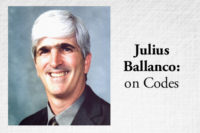Most engineers would have to be brutally honest and answer, “Basically nothing.” Perhaps that is one of the reasons for such limited participation on standard committees by design engineers. Is it that most design engineers do not care and they leave the writing of standards to others?
Yet, in the code world standards are scrutinized to the “nth” degree. So how important are these referenced standards and what should an engineer know regarding them?
The best way to describe it is that codes cannot exist without referenced standards. Without referenced standards every code would be 100 times larger in size. In other words, the content of the standards would have to be listed in the code.
Most engineers immediately think of product standards when the term “referenced standard” is used. They also consider these standards to be for the manufacturer of the given product. While that is true, there often times is information for the design engineer in these product standards. Fortunately, the manufacturer often includes this information in the installation instructions.
What often is forgotten is that the product standard requires the manufacturer to list various requirements in its installation instructions. So while an engineer may think that a certain installation requirement is the manufacturer’s own idea, quite often the requirement is specified in the reference standard. This is especially important to understand if there ever is any litigation over a design issue.
Putting it in focus
Product standards will also have limitations for use. This is important to the engineering community. For example, the copper tube standard addresses copper tube supplying water. There is a caveat that allows other uses, provided the tube is further evaluated for those uses. If you are using copper tube for a special waste system, you need to be sure that the tube was further evaluated for that application.
While product standards are most common in plumbing, mechanical and fuel gas codes, there are other categories of standards that appear. Four common types of standards are: testing standards, design standards, installation standards and personnel certification standards.
Many of the fire rating standards are test standards. When you specify a one-hour-rated assembly, what does that mean? Will the assembly hold up for one hour in a fire?
If you investigate, you will find that most fire test standards use the same time/temperature curve. This curve dates back nearly 100 years. So if a fire burns hotter than the curve, the assembly may last shorter than the designated hourly rating. If the fire does not burn as hot as the curve, the assembly may last longer. The ratings merely indicate that the assembly passed the test specified in the standard. It does not predict performance in an actual fire.
Hitting close to home
Design standards should be near and dear to an engineer because they specify the design requirements of a particular system. For example, the ASSE standard on sovent lists the design requirements and limitations for a sovent system. The reliance for the design cannot be based on the manufacturer, rather it must be based on the standard. If you don’t have a copy of the standard, you cannot design a sovent system. The same can be said for a siphonic roof-drainage system. You better have a copy of the ASPE standard.
Installation standards also are important for the design engineer. While these standards tend to be geared toward the installing contractor, there is information in these standards that must be included in the design of a system. A good example would be the installation of underground plastic pipe. There is an installation standard that identifies the trenching and bedding requirements for buried pipe. The details on your plans better be coordinated with this standard.
Personnel certification standards can be included in engineering specifications as a means of regulating the quality of the installing contractor. There are certification standards for various job functions. One that I use all the time is the certification of a balancing contractor. I want the balancing contractor for the HVAC system to be qualified to perform that task. Other examples would be a backflow tester or medical gas installer. There are standards that regulate the certification of these contractors. Again, it is a good reference to add to your specifications.
The reference standards found in the codes are required to be consensus standards. This means that they are developed by a broad range of individuals and they need your input. It is unfortunate there is only a limited number of design engineers involved in the writing of reference standards.
Get engaged
On the mechanical side, ASHRAE seems to do very well getting design engineers involved. On the plumbing side, the participation is poor. More design engineers are needed on just about every referenced standard.
ASPE has about 7,000 members. Of that, it is estimated that less than 300 members participate as members of standard writing committees. Of those ASPE members on standard committees, more than half work for manufacturers. That’s not to say that is bad. We need manufacturing representatives on standard committees. But we also need design engineers.
The ASME A112 Committee, which regulates all plumbing fixtures and other plumbing products, currently has a membership of more than 30 people. They limit the committee to 35 (I believe). When you look at the people on this committee, only two members can be classified as design engineers. There used to be three, but one member recently retired. Hence, there needs to be more design engineers.
If you have never served on a consensus standard committee, it is time for you to think about joining. Your participation will benefit the engineering community. It also will benefit you since it is a great way to become further educated on a given subject matter. Finally, it will benefit your company by promoting its involvement and increasing the knowledge of its staff.



